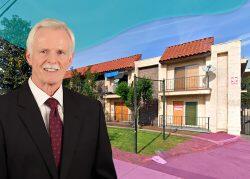The nation’s sheltered homeless population is highly concentrated in four states, with New York, California, Florida and Massachusetts all accounting for significant shares, according to a HUD report published on Friday.
The federal agency’s Annual Homeless Assessment Report to Congress aims to provide a snapshot of homelessness throughout the country based on data derived from “point in time” counts. The methodology aims to measure the number of individuals and families living on the streets and in shelters on a single night in January. The agency typically releases its findings in two parts, focusing on sheltered and unsheltered homeless populations.
The just-released report focused on sheltered homeless.
Recent counting estimates have been complicated by the pandemic, but HUD found 326,000 Americans were living in shelters on a single night in January 2021. That overall figure represented an eight percent decline from the 2020 count, continuing a trend that’s been ongoing since 2015, the report noted.
It was unclear exactly why the number dropped in 2021: The authors suggest it could be in part because of shelters’ pandemic-era adjustments — many moved beds farther apart as a safety precaution, thereby reducing overall capacity — as well as from eviction moratoriums and other government measures that effectively kept vulnerable people in their homes. Last year’s data on unsheltered homeless is relatively scarce because many communities did not conduct unsheltered counts, the report notes, but in communities that did conduct the counts unsheltered populations did not appear to increase.
Yet even as the overall numbers of sheltered homeless trended down, the numbers remained particularly high in a handful of states, with New York, California, Florida and Massachusetts accounting for just under half the total figure.
That’s not a surprise — those states also represent four of the five states with the highest number of beds available — but the figures nevertheless point to what seems to be a high concentrations of homelessness in the country’s most urban and expensive regions.
In the report New York State had by far the country’s biggest sheltered homeless population, with 76,000 people occupying 86,000 available beds. California, with 51,000 people occupying 72,000 beds, was second, followed by Florida and Massachusetts, which counted 14,000 and 13,000 sheltered homeless.
The sheltered data, of course, only offers a limited picture: In relatively cold New York City, where local laws mandate shelter access, the majority of people experiencing homeless are in shelters; in California, where no such mandate exists, a much higher portion of the homeless live in vehicles and on the streets.
And in recent years it’s been California — which has see a soaring residential market and inventory shortage in recent years — that’s represented a kind of highly visible epicenter of American homelesseness. In Los Angeles, where over the past couple years the authorities have orchestrated highly controversial encampment sweeps, the crisis has also emerged as a central political issue, including in this year’s mayoral race, and also drawn the attention of high-ranking executives of the real estate industry.
Read more


